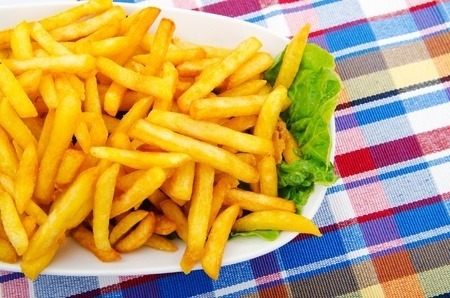
Acrylamide is one of the nastiest chemicals to be found in food. For a start it is odourless and forms a colourless crystalline monomer but with significant reactivity with a range of other compounds as well as itself.
It is so poisonous, the International Agency for Research on Cancer classified AA as a probable carcinogen in humans, in 1994 (Markovic et al., 2018).
Other names for acrylamide include 2-propenamide.
Industrially, it is extremely important because it is a raw material for many processes including the manufacture of polymers such as polyacrylamide for clothing and for managing wastewater treatment. It is also needed for cosmetics production and in various types of dye and pigment manufacture (Abdel-Daim et al., 2015; Acaroz et al., 2018).
Occurrence
Acrylamide is often found in food especially fried foods. It has been detected in french fries, biscuits, breakfast cereals, crackers, crisps, bread and toast and in roasted coffee (Zhang et al., 2012; Loaec et al., 2014; Markovic et al., 2018).
A number of other studies have established levels in foods:
(a) Chen et al., (2012) measured acrylamide levels in a range of Chinese foods ranging from 0.41 to 4,120 μg/kg. Prawn strips, fried potato foods and rice crusts had the highest levels recorded.
(b) Lee et al., (2013) checked levels in 274 Korean processed foods and found levels up to 1,435 μg/kg. Potato chips contained the highest amounts whilst nut based foods had the lowest.
(c) Potato crisps often have the highest levels and are a major cause of concern for acrylamide formation. The maximum amount in Austrian sourced crisps was 1500 μg/kg (Murkovic, 2004), 2528 μg/kg in crisps from a Brazilian market (Arisseto et al., 2007) and 3647 μg/kg in crisps from Poland (Mojska et al., 2006).
(d) Coffee. There is good understanding of how the level of acrylamide forms during the roasting of coffee and then declines from a maximum due to both physical removal and further chemical reactions. Lightly roasted coffees are worse than dark roasted versions.
(e) Baked food. Acrylamide forms when particular leavening agents are used. The highest levels are recorded when ammonium hydrogen carbonate (NH4HCO3) is used. The level of acrylamide produced is about 6 times higher when compared to a control when no raising agents were present. The levels are suppressed when other raising agents are used such as sodium hydrogen carbonate (NaHCO3) up to 52 %. Sodium pyrophosphate (Na4P2O7) had no influence apparently on the final acrylamide content.
A database has been established by the Institute for Reference Materials and Measurements (IRMM) of the European Commission and the U.S. Food and Drug Administration (FDA, 2006; Joint Research Centre (JRC) European Commission, 2008).
How Is Acrylamide Produced?
Acrylamide is produced by the Maillard reaction which occurs between amino acids and reducing sugars but with the amino acid, asparagine in particular. carbohydrate-rich foods are particularly susceptible especially when they are cooked at high temperatures as in frying (Zhang et al., 2012).
Acrylamide is formed to a much lesser extent from lipids in the absence of sugars like glucose (Ehling et al., 2005) .
Properties
It is highly water soluble and of low molecular weight. It is also easily absorbed in the gastrointestinal tract and widely distributed throughout the body (Yildizbayrak & Erkan, 2018).
Extraction And Analysis Of Acrylamide
The FDA has an established method from 2003.
Toxicity Of Acrylamide
Acrylamide has diverse, well‐known toxic effects, including neurotoxicity, genotoxicity, reproductive toxicity, and immunotoxicity in cell lines and animal models (Zhang et al., 2012; Fang et al., 2014; Liu et al., 2015; Zamani et al., 2017).
Toxicity due to acrylamide is associated with oxidative stress (Oliveira et al., 2009; Pan et al., 2018).
References
, , & (2015). Trigonella foenum‐graecum ameliorates acrylamide‐induced toxicity in rats: Roles of oxidative stress, proinflammatory cytokines, and DNA damage. Biochemistry and Cell Biology, 93(3), pp. 192–198. (Article)
, , , , , , … (2018). The ameliorative effects of boron against acrylamide‐induced oxidative stress, inflammatory response, and metabolic changes in rats. Food and Chemical Toxicology, 118, pp. 745–752. (Article)
, , , & (2014). Immunotoxicity of acrylamide in female BALB/c mice. Biomedical and Environmental Sciences, 27(6), pp. 401–409. (Article)
, , , , , , & (2015). Acrylamide induces mitochondrial dysfunction and apoptosis in BV‐2 microglial cells. Free Radical Biology and Medicine, 84, pp. 42–53. (Article)
, , , , & (2014). Acrylamide, 5‐hydroxymethylfurfural and N‐epsilon‐carboxymethyl‐lysine in coffee substitutes and instant coffees. Food Additives and Contaminants Part A‐Chemistry Analysis Control Exposure & Risk Assessment, 31(4), pp. 593–604. (Article)
, , , & (2018). Effects of acrylamide on oxidant/antioxidant parameters and CYP2E1 expression in rat pancreatic endocrine cells. Acta Histochemica, 120(2), pp. 73–83. (Article)
2004. Acrylamide in Austrian foods. J. Biochem. Biophys. Methods 61 pp. 161–167.
Oliveira, N. G., Pingarilho, M., Martins, C., Fernandes, A. S., Vaz, S., Martins, V., … Gaspar, J. F. (2009). Cytotoxicity and chromosomal aberrations induced by acrylamide in V79 cells: Role of glutathione modulators. Mutation Research‐Genetic Toxicology and Environmental Mutagenesis, 676(1–2), pp. 87–92. (Article).
, , , , , & (2018). Acrylamide‐induced oxidative stress and inflammatory response are alleviated by N‐acetylcysteine in PC12 cells: Involvement of the crosstalk between Nrf2 and NF‐kappa B pathways regulated by MAPKs. Toxicology Letters, 288, pp. 55–64. (Article)
, & (2018). Acrylamide disrupts the steroidogenic pathway in Leydig cells: Possible mechanism of action. Toxicological and Environmental Chemistry, 100(2), pp. 235–246. (Article)
, , , & (2017). Acrylamide induces immunotoxicity through reactive oxygen species production and caspase‐dependent apoptosis in mice splenocytes via the mitochondria‐dependent signaling pathways. Biomedicine & Pharmacotherapy, 94, pp. 523–530 (Article)
, , , & (2018). In vitro study towards role of acrylamide‐induced genotoxicity in human lymphocytes and the protective effect of L‐carnitine. Brazilian Archives of Biology and Technology, 61. (Article)
, , , , , & (2012). Protective effect of allicin against acrylamide‐induced hepatocyte damage in vitro and in vivo . Food and Chemical Toxicology, 50(9), pp. 3306–3312 (Article).


Leave a Reply